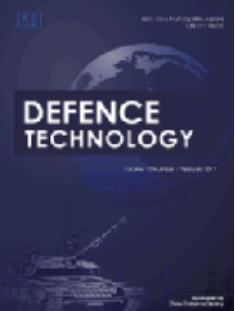钢靶在长杆侵彻下的变形规律
IF 5.9
Q1 ENGINEERING, MULTIDISCIPLINARY
引用次数: 0
摘要
通过试验和有限元模拟研究了钨合金长杆侵彻过程中钢靶的变形规律,以及靶强度对变形规律的影响。实验结果表明,在瞬态进入阶段,钢靶第一层的质量损失很小,在准稳定侵彻阶段,目标质量损失几乎可以忽略不计。宏观分析、微观分析和仿真结果表明,被侵蚀的靶材向弹坑外围迁移,导致靶材厚度增加,并没有流出弹坑,而是停留在靶材内部。因此,长杆穿透金属靶的过程被认为是向后挤压的过程。将反向挤压理论与能量守恒理论相结合,建立了考虑弹坑直径和杆与靶间摩擦系数的长杆侵彻金属靶的侵彻深度模型。虽然该模型尚不完善,但它创新地将固体力学原理应用于长杆贯入的研究。此外,它还考虑了钻杆在穿透过程中与目标之间的摩擦系数。因此,该模型为今后的长杆侵彻研究提供了新的研究方向。本文章由计算机程序翻译,如有差异,请以英文原文为准。
Deformation patterns of steel targets against long rod penetration
An experimental and finite element simulation investigation are conducted to study the deformation patterns of steel targets during the penetration process of tungsten alloy long rods, as well as the influence of strength of the target on the deformation patterns. The experimental results revealed slight mass loss in the first layer of the steel target during the transient entrance phase, with an extremely negligible loss in target mass during the quasi-steady penetration phase. The results of macro-analysis, micro-analysis and simulation show that the eroded target material migrated towards the periphery of the crater, causing an increase in the target's thickness, remained within the target, instead of flowing out of the crater. Therefore, the process of long rods penetrating the metal target is considered as a process of backward extrusion. By combining the backward extrusion theory with energy conservation, a penetration depth model for long rods penetrating a metal target, taking into account both the diameter of the crater and the friction coefficient between the rod and the target, has been established. Although the model is not yet perfect, it innovatively applies the principles of solid mechanics to the study of long rod penetration. Additionally, it takes into account the friction coefficient between the rod and the target during the penetration process. Therefore, this model provides a new research direction for future studies on long rod penetration.
求助全文
通过发布文献求助,成功后即可免费获取论文全文。
去求助
来源期刊

Defence Technology(防务技术)
Mechanical Engineering, Control and Systems Engineering, Industrial and Manufacturing Engineering
CiteScore
8.70
自引率
0.00%
发文量
728
审稿时长
25 days
期刊介绍:
Defence Technology, a peer reviewed journal, is published monthly and aims to become the best international academic exchange platform for the research related to defence technology. It publishes original research papers having direct bearing on defence, with a balanced coverage on analytical, experimental, numerical simulation and applied investigations. It covers various disciplines of science, technology and engineering.
 求助内容:
求助内容: 应助结果提醒方式:
应助结果提醒方式:


